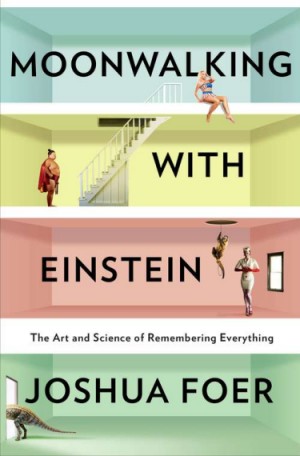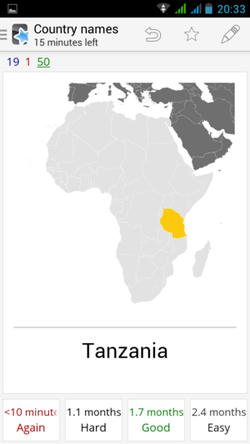Memory techniques
16 Oct 2015I recently gave a talk about memory techniques that I use. I'm posting a summary here for those that could not attend.
The memory I talked about had nothing to do with RAM, but with the memory inside our brain. I read a book named Moonwalking with Einstein, by Joshua Foer and wanted to share what I learned from it.

It tells the story of a journalist that met a memory champion. Like me, he did not know that there were memory contests, and that one could become a champion of it. Nevertheless, he learned several techniques from this champion and in one year was able to enter the world contest himself.
The book is really easy to read, it flows like a novel. But everytime a new technique was explained, I tried it on my own brain, to see if this was working.
Mental images
The first one is not a technique in itself. It's the main brick upon which all other techniques are based. The idea is to understand what our brain can do effortlessly, and what is very hard for it to do. Once we know that, we'll stop asking it to do hard stuff, and only focus on what it is naturally good at.
There are three main elements that makes something easy to remember. First, if it's unique, rare or weird, you'll remember it much more easily than something common and mundane. Second, if you can see it, smell it, hear it, taste it or touch it, than it feels more real and you'll remember it better. Finally, if it makes you feel something, either joy, anger or sadness, you'll have personnaly lived it, so you'll remember.
Another really nice characteristic of our brain is that it can remember things that never happened. You can close your eyes and imagine that a giant dinosaure is walking down your street, breathing fire and burning buildings. This never happens (and never will), but you can picture it. In a few days you might even remember it.
Memory palace
The first real technique is called the Memory Palace. It uses one more thing for which our brain is very powerful: spatial representation. You just have to spend 30s in an apartment you don't know to have an accurate representation of the various rooms, their volume and how they are arranged together. For places you've visited often, this is even more powerful. You can just close your eyes and mentally navigate in your childhood home, your apartement, or your job place.
So the Memory Palace is a way to remember an ordered list of elements, like a grocery list. Instead of writing it down on a paper, close your eyes and mentally walk inside your appartement, and put one element of your list in each room. But do not simply picture you putting it in the room. Emphasize it. Extrapolate it. Make it unforgettable.
For example if you need to buy cheese and eggs, imagine that the walls and ceiling of your kitchen have melting cheese all over them, or that all your furnitures turned to Swiss cheese. Instead of putting 6 eggs in your living room, picture them seated in your sofa, having a drink and a chat. The weirdest, the better.
Then, instead of reading your list, picture yourself walking in your appartement, one room at a time, and the crazy mental images will pop from memory directly. Try it if you don't trust me, it really works even on the first try. The first time I did it I was able to remember a list of 20 elements easily (my appartement is not that big, you can put several elements per room). The best part is that I still remembered the list months later.
Spaced repetition
The second technique is called spaced repetition and is a way to not forget what you learn. We've all experienced it before. On an exam eve, you stay up late and learn as much as you can in a short time. You remember most of it for the exam, but then one week later, you've forgotten everything.
This happens because your short term memory will disappear if you do not call it. The spaced repetition technique lets you remember things right before you forgot them. I personnally use the AnkiDroid application for that.

You create (or download) a deck of cards on a subject (all the countries of the world and their flags for example). Each card of the deck is two-sided, with a question on one side and the answer on the other. When you draw the first card of the deck, you'll see the question. You mentally think the answer, then press the "Ok" button to see the real answer.
If you were right, we press the "Good" button and it will ask this same card again the next day. If you're still right tomorrow, it will ask you in a few days, then a week, a month, etc. But if you're wrong it will ask you again in 10mn until you got it right. Everyday it will add a few new cards to the one you've already seen.
The one you've trouble remembering will keep popping day after day until you remember them. The one you remember easily will not be asked often.
The best thing is not even that this works well, it's that it is really fun to do. In one month (20mn in the subway every morning), I learned the whole countries and flags decks. I found it so fun that I then started to learn their capitals and the USA states and capitals.
I would have loved to have known this technique when I was still a student. This would have made my learning so much quicker and enjoyable. Knowing this technique I am now confident that I can learn anything, given enough time, and without pain.
Conclusion
This book told me how to write stuff to my brain so I can easily pull it later. To be honest I rarely use this technique. I do my shopping online and can always check stuff on Wikipedia if I forgot. But I'm happy to know how my own brain is working.
Want to add something ? Feel free to get in touch on Bluesky : @pixelastic.bsky.social